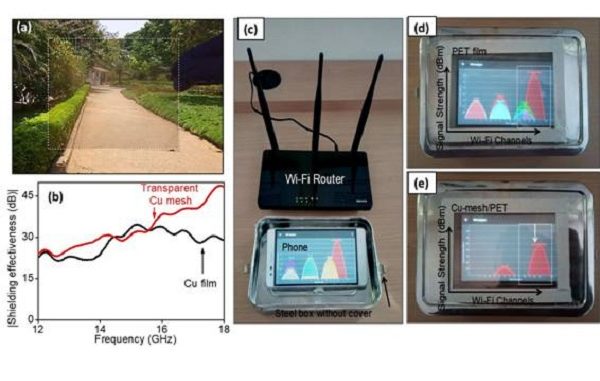
Aug 18: HG Wells’ ‘Invisible Man’ tweaked the optical properties of the body to become invisible. Scientists have now achieved a similar feat by designing a metal mesh structure instead of the continuous film on desired transparent substrates to make it a transparent shield for electromagnetic interference (EMI). The invisible shield can be used in various military stealth applications and can cover electromagnetic wave emitter or absorber devices without compromising their aesthetics.
Scientists from Centre for Nano and Soft Matter Sciences (CeNS), Bengaluru, an autonomous institute of the Department of Science & Technology, Govt. of India have fabricated these transparent and flexible EMI shields made of metal meshes using the crack templating method via spray coating which is pioneered in their laboratory.
The CeNS team has developed a copper metal mesh on polyethylene terephthalate (PET) sheet as its substrate, which exhibited a visible transmittance (T), a parameter of visible transparency of about 85% and sheet resistance (Rs) ~ 0.83 ohm per square. These transparent and flexible EMI shields made of metal mesh coatings on desired transparent substrate they have developed through their research published in the journal ‘Bulletin of Materials Science’ showed remarkably high values for total EMI shielding (SET), with the average value being ~ 41 dB over a wide spectral range of the Ku band (12 to 18 GHz).
Instead of continuous film of metal (Cu) coating on any transparent substrate (glass, PET) where transparency can be compromised. In this method, the CeNS team has deposited metal mesh networks on the substrate, which covers only 7% area of substate, unlike 100% coverage of continuous film. This makes metal mesh transparent compare to continuous metal film. Metal mesh provides better electromagnetic shielding compare to same thickness of continuous metal film where transparency can be compromised.
This metal mesh can be created on any desired substrates such as acrylic, polycarbonate, glass, etc. without compromising the conductivity of the electrodes.
Dr. Ashutosh K Singh, Scientist at CeNS and working on this project, said, “this invention has the potential to satisfy the huge demand for highly effective transparent and flexible EMI shields, which can cover electromagnetic wave emitter/absorber devices without compromising their aesthetics.”
These transparent EMI shields have been exhibited in various prestigious Expos and conferences such as Bangalore INDIA NANO-2018 & 2020, ICONSAT-2018 & 2020, SPIE-2019, etc. for dissemination and marketing purpose. The shields are available for onsite testing and validation purposes.
The team lead by Prof. G U Kulkarni, along with his co-workers from CeNS and industrial partner Hind High Vacuum (HHV) Pvt. Ltd. has set-up a semi-automated production plant funded by DST-Nanomission in CeNS-Arkavathi campus for production of transparent conducting glasses which shows the potential for transparent EMI shields as well.
Disclaimer: We donot claim that the images used as part of the news published are always owned by us. From time to time, we use images sourced as part of news or any related images or representations. Kindly take a look at our image usage policy on how we select the image that are used as part of the news.


